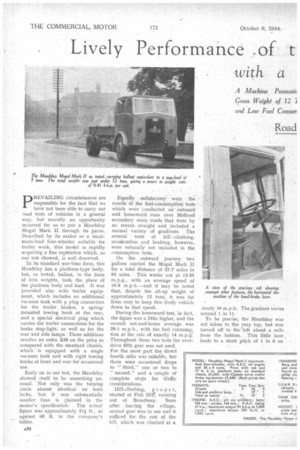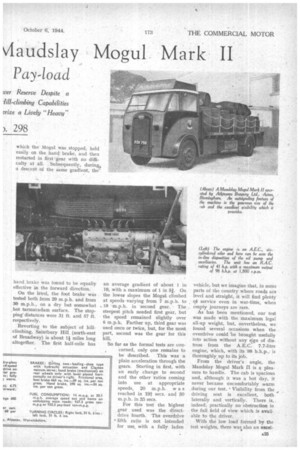Lively Performance of t vlaudslay Mogul Mark II
Page 26

Page 27

Page 28

If you've noticed an error in this article please click here to report it so we can fix it.
with a
Pay-load
pREVAILING circumstances are responsible for the fact that we have not been able to carry out road tests of vehicles in a general way, but recently an opportunity occurred for us to put a Maudslay Mogul Mark II through itspaces. Described by its maker as a maximum-load four-wheeler suitable for trailer work, this model is rapidly acquiring a fine reputation which, as our test showed, is well. deserved.
In its standard war-time form, this Maudslay has a platform-type body, but, as tested, ballast, in the form of iron weights, took the place of the platform body and load. It was provided also with trailer equipment, which includes an additional vacuum tank with a plug connection for the trailer brakes, a springmounted towing hook at the rear, and a special electrical plug which carries the trailer connections for the brake stop-light, as well as for the rear and side lamps. These additions involve an extra £30 on the price as compared with the standard chassis, which is equipped with a single vacuum tank and with rigid towing hooks at front and rear for occasional use.
Early on in our test, the Maudslay showed itself to be something unusual. Not only was the turning circle almost identical on both locks, but it was substantially smaller than is claimed in the maker's specification. The actual figure was approximately 514 ft., as against 60 ft. in the company's — folder. Equally satisfactory were the results 'of. the fuel-consitmption tests which were conducted on outward and homeward runs over Midland secondary main roads that Were by no means straight and included a normal variety of gradients. The several tests of hill-climbing, accoleration and braking, however, were naturally not included in the consumption tests.
On the outward journey two gallons carried the Mogul Mark II for a total distance of 27.7 miles in 84 mins. This works out at 13.85 m.p.g., with an average speed of 19.8 m.p.h.—and it may be noted that, despite the all-up weight of approximately 12 tons, it was far from easy to keep this lively vehicle down to that speed.
Hill-climbing, prope r, started at Fish Hilt running out of Broadway. Soon after leaving the village, second gear was in use and it sufficed for the rest of the hill, which was climbed at a ,teady 10 m.p.h. The gradient varies around 1 in 11.
To be precise, the Maudslay was not taken to the very top, but was turned off to the 'left about a mile from the bottom. This little lane leads to a short pitch of 1 in 6 on
which the Mogul was stopped, held easily on the hand brake, and then restarted in first gear with no difficulty at all. Subsequently, during; a descent of the same gradient, the"
hand brake was found to be equally effective in the forward direction.
On the level, the foot brake was tested both from 20 m.p.h. and from 30 m.p.h., on a dry but somewhat hot tarmacadam surface. The stopping distances were 31 ft. and 57 ft. respectively.
Reverting to the subject of hillclimbing, Saintbury Hill (north-east of Broadway) is about l miles long altogether. The first half-mile has an average gradient of about 1 in 10, with a maximum of 1 in 51. On the lower slopes the Mogul climbed at speeds varying from 7 m.p.h. to 10 m.p.h. in second gear. The steepest pitch needed first gear, but the speed remained slightly over 6 m.p.h. Farther up, third gear was used once or twice, but, for the most part, second was the gear for this hill.
So far as the formal tests are concerned, only one remains to be described. This was a plain acceleration through the gears. Starting in first, with an early change to second and the other ratios coming into use at appropriate speeds, 20 m.p.h. was reached in 19,1 secs. and 30 m.p.h. in 35 secs.
For this test the highest gear used was the directdrive fourth. The overdrive fifth ratio is not intended for use, with a fully laden vehicle, but we imagine that, in some parts of the country where roads are level and straight, it will find plenty gk service even in war-time, when empty journeys are rare.
As has been mentioned, our test was made with the maximum legal all-up weight, but, nevertheless, we found several occasions when the overdrive could 'be brought usefully into action without any sgn of distress from the A.E.C. 7.7-litre engine, which, with its 98 b.h.p., is thoroughly up to its job.
From the driver's angle, the Maudslay Mogul Mark II is a pleasure to handle. The cab is spacious and, although it was a hot day, it never became uncomfortably warm during our test. • Visibility from the driving scat is excellent, both laterally and vertically. There is, indeed, practically no obstruction in the full field of view which is available to the driver.
With the low load formed by the test weights, there wasp alsoan excelA25
lent rearward view through the window in the back of the cab. However, even if that were obstructed, reversing would still be easy with the wide side window.
All the controls were found to be light in use. The 21-in, spring
steering wheel, in conjunction with a double-roller steering box, took most of the work out of this operation, and the same service was performed in respect of braking by the ClaytonDewandre vacuum servo; in conjunction with the hydraulically operated two-leading-shoe Girling equipment. Despite its direct mechanical operation and its ability to hold the 12-ton outfit in either direction on a steep hill, the hand 15rake also was remarkably light.
Similarly, the type 16R2 Borg and Beck clutch required no heavier pedal pressure than is normal on many a light car. Pedal travel ivas greater, of course, but Was not noticeably so.
In the past there have been heavy vehicles in which that adjective applied quite as much to the work of -driving them as to the work which those vehicles themselves could safely do. This Maudslay is not that sort of job at all. It is light to handle, light to refuel and lighthearted in its performance. The only heavy part about it is the load.




















































